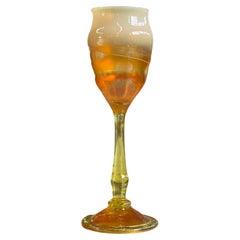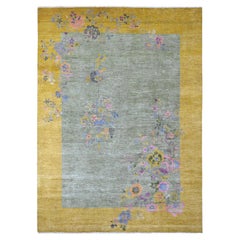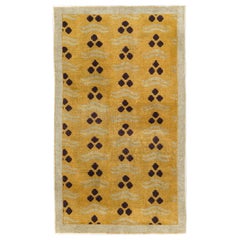Glass Chinese and East Asian Rugs
to
Width
to
Length
to
1
1
1
1
150,043
5,322
4,968
523
452
1
1
1
1
1
1
1
Material: Glass
Tiffany Favrile Iridescent Glass Goblet
Located in Los Angeles, CA
Louis Comfort Tiffany iridescent and gold favrile glass goblet. Paper label on base.
Dimensions:
9.75"H x 3.5"D.
Category
1910s American Vintage Glass Chinese and East Asian Rugs
Materials
Glass
Related Items
9'1"x12'5" Sage Green Chinese Art Deco Inspired Peshawar Hand Knotted Wool Rug
Located in Carlstadt, NJ
Sage Green, Chinese Art Deco Inspired Peshawar, Hand Knotted, Natural Dyes, 100% Wool, Oriental Rug
Primary materials: Wool
Latex: No Pile
height: 0.25 Inches
Style: Transitional
Pr...
Category
2010s Afghan Art Deco Glass Chinese and East Asian Rugs
Materials
Wool
Mid-20th Century Handmade Turkish Art Deco Throw Rug in Gold and Silver-Grey
Located in New York, NY
A vintage Turkish Anatolian Art Deco throw rug handmade during the mid-20th century with a goldenrod field and silver-grey border. The Cintamni pattern of 3 stones is in dark brown a...
Category
Mid-20th Century Turkish Art Deco Glass Chinese and East Asian Rugs
Materials
Wool
Late 19th Century Chinese Khotan Carpet
Located in New York, NY
Late 19th century Khotan carpet
china ca. 1890
handwoven
Category
Late 19th Century Chinese Khotan Antique Glass Chinese and East Asian Rugs
Materials
Wool
Pair of Chinese Art Deco Carpet Runners
Located in Atlanta, GA
Pair of Chinese Art Deco carpet or rug runners, circa 1930s. Beautiful colors and rare to find a pair. They measure 45" length x 23" width each. Th...
Category
1930s Unknown Chinoiserie Vintage Glass Chinese and East Asian Rugs
Materials
Wool, Fabric
Qashqai Refracted Silk Rug Hand Knotted Contemporary Modern Design
Located in Lohr, Bavaria, DE
A beautiful contemporary abstract modern design rug, hand knotted using finest Chinese mulberry silk in 8 x 6 ft size.
By Djoharian Design.
Modern desiger rug Qashqai Lion...
Category
2010s Nepalese Modern Glass Chinese and East Asian Rugs
Materials
Silk
A Pair of Antique Art Deco Chinese Oriental Rug, 2' x 3'10" Each
Located in Evanston, IL
Pair of antique handmade Art Deco Chinese Oriental Rugs, 2' x 3'10 each", c-1920, traditional floral pattern with red and green background color. This rug is in excellent condition, ...
Category
Early 20th Century Chinese Art Deco Glass Chinese and East Asian Rugs
Materials
Wool
Oval Mid-20th Century Handmade Chinese Art Deco Accent Rug in Red and Goldenrod
Located in New York, NY
A vintage Chinese Art Deco accent rug, in an oblong oval shape, handmade during the mid-20th century with a floral pattern over a magenta-red field and goldenrod yellow border.
Me...
Category
Mid-20th Century Chinese Art Deco Glass Chinese and East Asian Rugs
Materials
Wool
Mid-20th Century Handmade Chinese Art Deco Accent Carpet
Located in New York, NY
A vintage Chinese Art Deco accent carpet handmade during the mid-20th century.
Measures: 6' 1" x 8' 11"
Category
Mid-20th Century Chinese Art Deco Glass Chinese and East Asian Rugs
Materials
Wool
Early 20th Century Handmade Mongolian Art Deco Style Room Size Carpet In Neutral
Located in New York, NY
An antique Mongolian room size carpet handmade during the early 20th century with a contemporary Art Deco style geometric pattern in neutral colors.
Measures: 9' 2" x 11' 1"
The craft of the hand-knotted carpet in China, and the surrounding areas including Mongolia and Tibet, extends into the early centuries of the first millennium, C.E., but we really have a firm grasp only beginning in the later 16th century with large, very coarsely woven carpets, often depicting dragons, created for the Imperial Forbidden City palaces. Chinese carpets have always been commercial and there are no tribal groups responsible for any of the carpet weaving strains.
When the Ming Dynasty fell in 1644, with no Imperial patrons, production moved to the city of Ningxia in north central China where several workshops turned out more finely woven pieces for the Mandarins of the administrative Ch’ing bureaucracy and well-to-do merchants. Ningxia was the major Chinese carpet center up through most of the 19th century, with first allover and then medallion designs on cotton foundations in medium weaves. Palettes were initially limited to yellows, dark blue and cream, but later widened to include reds, browns and even green. These antiques were the first Chinese carpets to be exported to the West and they fitted in well with the craze for Chinese blue-and-white porcelain in the second half of the 19th century. Ningxia also wove shaped and rectangular small rugs for saddle underlays, chair (“throne”) seats and shaped backs, pillar carpets with dragons or monks for Buddhist monasteries, and long divided runners for monastery meditation halls. These small rugs are among the most collectible of all Chinese weavings.
Weavers from Ningxia set up workshops in the capital Peking (Beijing) in the 1860’s and began weaving Western room sizes for export, primarily to America. In blue – and – white and polychrome palettes, with round wreath medallions, precious objects, seasonal flowers, paeonies, lotuses, fretwork, clouds, butterflies and bats, all relatively spaciously drawn. The round “Shou” (Good Luck) character is also a prominent decorative motif. There are also a few Peking landscape pictorials with pagodas, houses, bridges, waterscapes and boats. Peking carpets were woven right up until WWII and production began again after the Cultural Revolution around 1970. They are moderately well-woven, on cotton foundations, exactingly executed and indisputably Chinese. Many are in the blue-and-white style. Nothing else looks like a Peking carpet and for a Chinese “look” in a room, they are absolutely indispensable. Sizes range from scatters and a few runners, through the popular 9’12’ size, to large carpets over 20’ which must have been special orders. The earliest Peking Revival carpets are pliable and fairly thin, but they became heavier and more compact in the 20th century, in competition with Art Deco carpets from Tientsin. The modern, post- 1970, pieces are in the traditional Peking style, but are a little too regular and neat. Exactitude has been favored over character, as hard to explain that as it is.
There are a number of all-silk and silk-and –metal thread pieces, many with inscriptions purporting to link them with rooms in the Imperial palaces, bringing very substantial auction prices, but none are really antique. The genre emerged after WWI and the present demand comes from mainland Chinese. The silk piles often stand in pattern relief against flat woven gold metal thread grounds. The inscriptions are apocryphal, the rugs are flashily opulent, perfect for nouveaux riches.
The Art Deco period between the two World Wars saw a distinctive carpet industry developing in Tientsin (Tianjin) in northeastern China. These are highly prized for their transitional design character, neither overtly Chinese, nor abstractly modern/contemporary. Woven exclusively for export, usually by and for American firms, such as Nichols and Elbrook, they are totally in the “Jazz Age Modern” style of the 1920’s, often without borders, with abstract or abstracted patterns, and only with, at best, a few Chinese-y pattern elements. Vases asymmetrically placed in the corners are features of some of the more Chinese-y carpets. Open fields with floral sprays and branches growing in from the edges are anther design innovation. Often, Chinese motives have been re-imagined in more sharp-edged, abstract manners. Some have no references whatsoever to natural elements. The patterns are sharp and the rugs are never subdued, soft or restrained. The rugs are heavily constructed, with crisp, unfading dyes and medium to medium coarse weaves on cotton foundations. All are extremely well-executed, with none of the vagaries, variations or twists found on even high-quality Persian rugs. The majority are in the 9’ by 12’ format and a surprising number can be found in top condition. There also was a substantial production in Peking from, especially from the Fette factory. Elliptical and round carpets, and lighter, often pastel colors, were a specialty. Nothing looks like an Art Deco Chinese and they work well with traditional Chinese furniture and the most modern decor as well. These is no substitute for a good Chinese Art Deco carpet.
Chinese carpets also include small scatters from Tibet, with high quality wool, floating dragons and allover textile patterns. The colors of vintage and modern pieces are bright, but there are antique small rugs (sleeping rugs) with simple chessboard allovers. Only a few large antique Tibetan carpets...
Category
Early 20th Century Mongolian Art Deco Glass Chinese and East Asian Rugs
Materials
Wool
Fragment of the Antique Tiffany Chinese Carpet with Lotus Flowers
Located in Milan, IT
The only huge carpet known to have left the Imperial Palace in Beijing's Forbidden City, formerly in the Perenchio collection, is the famous Tiffany carpet, 9.99 metres long and once 9.68 metres wide, but since reduced to 7.20 metres wide. The carpet was originally made in three parts to fit around the columns of an unknown hall, and was reportedly last used in China in the private temple of the Empress Dowager Cixi. It was purchased for Louis Comfort Tiffany of New York, who owned it for more than thirty years. The Tiffany carpet is currently attributed to the end of the Ming dynasty and is thought to have been made in the first part of the 17th century. The field pattern is composed of a repeating design of rows of lotus flowers on a soft beige ground, originally deep red, overlaid in the centre with a medallion formed by a blue line edged in ivory and pinched in the four corners. The field is enclosed by two borders on the same colour, which reappears beyond the borders to create a wide band around the outer edge. The inner border is composed of a lattice of stepped squares filled with a swastika, with a large rosette at each intersection. The outer border is a double version of the swastika fret. A section of the field is shown here, and a few other fragments survive.
The Tiffany carpet clearly forms a link between the carpets made during the late 16th century and those made in the late 17th century. Examples with an identical flower design or the same specific ‘heavy’ weave are now referred to as the ‘Tiffany’ type after this most important carpet. Other carpets of this type include one in the Nelson-Atkins Museum in Kansas City and one in the Metropolitan Museum of Art, New York. The Tiffany type...
Category
Early 17th Century Chinese Ming Antique Glass Chinese and East Asian Rugs
Materials
Wool
Yellow Blue Antique Chinese Room Size Rug
Located in New York, NY
A mid 20th century room size Chinese rug in blue and yellow. The wool and feel of the rug is very soft on the feet. It has a silky sheen to it a...
Category
Early 20th Century Chinese Mid-Century Modern Glass Chinese and East Asian Rugs
Materials
Wool
Mid-20th Century Handmade Chinese Art Deco Throw Rug
Located in New York, NY
A vintage Chinese Art Deco throw rug handmade during the mid-20th century.
Measures: 2' 8" x 3' 9"
The Craft of the hand-knotted carpet in China, and the surrounding areas including Mongolia and Tibet, extends into the early centuries of the first millennium, C.E., but we really have a firm grasp only beginning in the later 16th century with large, very coarsely woven carpets, often depicting dragons, created for the Imperial Forbidden City palaces. Chinese carpets have always been commercial and there are no tribal groups responsible for any of the carpet weaving strains.
When the Ming Dynasty fell in 1644, with no Imperial patrons, production moved to the city of Ningxia in north central China where several workshops turned out more finely woven pieces for the Mandarins of the administrative Ch’ing bureaucracy and well-to-do merchants. Ningxia was the major Chinese carpet center up through most of the 19th century, with first allover and then medallion designs on cotton foundations in medium weaves. Palettes were initially limited to yellows, dark blue and cream, but later widened to include reds, browns and even green. These antiques were the first Chinese carpets to be exported to the West and they fitted in well with the craze for Chinese blue-and-white porcelain in the second half of the 19th century. Ningxia also wove shaped and rectangular small rugs for saddle underlays, chair (“throne”) seats and shaped backs, pillar carpets with dragons or monks for Buddhist monasteries, and long divided runners for monastery meditation halls. These small rugs are among the most collectible of all Chinese weavings.
Weavers from Ningxia set up workshops in the capital Peking (Beijing) in the 1860’s and began weaving Western room sizes for export, primarily to America. In blue – and – white and polychrome palettes, with round wreath medallions, precious objects, seasonal flowers, paeonies, lotuses, fretwork, clouds, butterflies and bats, all relatively spaciously drawn. The round “Shou” (Good Luck) character is also a prominent decorative motif. There are also a few Peking landscape pictorials with pagodas, houses, bridges, waterscapes and boats. Peking carpets were woven right up until WWII and production began again after the Cultural Revolution around 1970. They are moderately well-woven, on cotton foundations, exactingly executed and indisputably Chinese. Many are in the blue-and-white style. Nothing else looks like a Peking carpet and for a Chinese “look” in a room, they are absolutely indispensable. Sizes range from scatters and a few runners, through the popular 9’12’ size, to large carpets over 20’ which must have been special orders. The earliest Peking Revival carpets are pliable and fairly thin, but they became heavier and more compact in the 20th century, in competition with Art Deco carpets from Tientsin. The modern, post- 1970, pieces are in the traditional Peking style, but are a little too regular and neat. Exactitude has been favored over character, as hard to explain that as it is.
There are a number of all-silk and silk-and –metal thread pieces, many with inscriptions purporting to link them with rooms in the Imperial palaces, bringing very substantial auction prices, but none are really antique. The genre emerged after WWI and the present demand comes from mainland Chinese. The silk piles often Stand in pattern relief against flat woven gold metal thread grounds. The inscriptions are apocryphal, the rugs are flashily opulent, perfect for nouveaux riches.
The Art Deco period between the two World Wars saw a distinctive carpet industry developing in Tientsin (Tianjin) in northeastern China. These are highly prized for their transitional design character, neither overtly Chinese, nor abstractly modern/contemporary. Woven exclusively for export, usually by and for American firms, such as Nichols and Elbrook, they are totally in the “Jazz Age Modern” style of the 1920’s, often without borders, with abstract or abstracted patterns, and only with, at best, a few Chinese-y pattern elements. Vases asymmetrically placed in the corners are features of some of the more Chinese-y carpets. Open fields with floral sprays and branches growing in from the edges are anther design innovation. Often, Chinese motives have been re-imagined in more sharp-edged, abstract manners. Some have no references whatsoever to natural elements. The patterns are sharp and the rugs are never subdued, soft or restrained. The rugs are heavily constructed, with crisp, unfading dyes and medium to medium coarse weaves on cotton foundations. All are extremely well-executed, with none of the vagaries, variations or twists found on even high-quality Persian rugs. The majority are in the 9’ by 12’ format and a surprising number can be found in top condition. There also was a substantial production in Peking from, especially from the Fette factory. Elliptical and round carpets, and lighter, often pastel colors, were a specialty. Nothing looks like an Art Deco Chinese and they work well with traditional Chinese furniture and the most modern decor as well. These is no substitute for a good Chinese Art Deco carpet.
Chinese carpets also include small scatters from Tibet, with high quality wool, floating dragons and allover textile patterns. The colors of vintage and modern pieces are bright, but there are antique small rugs...
Category
Mid-20th Century Chinese Art Deco Glass Chinese and East Asian Rugs
Materials
Wool


